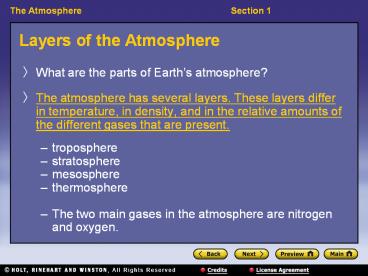Layers of the Atmosphere - PowerPoint PPT Presentation
Title:
Layers of the Atmosphere
Description:
Layers of the Atmosphere What are the parts of Earth s atmosphere? The atmosphere has several layers. These layers differ in temperature, in density, and in the ... – PowerPoint PPT presentation
Number of Views:1314
Avg rating:3.0/5.0
Title: Layers of the Atmosphere
1
Layers of the Atmosphere
- What are the parts of Earths atmosphere?
- The atmosphere has several layers. These layers
differ in temperature, in density, and in the
relative amounts of the different gases that are
present. - troposphere
- stratosphere
- mesosphere
- thermosphere
- The two main gases in the atmosphere are nitrogen
and oxygen.
2
Layers of the Atmosphere, continued
3
Layers of the Atmosphere, continued
- Almost all weather occurs in the troposphere.
- The troposphere is the atmospheric layer closest
to Earths surface. - The troposphere is the densest layer.
- Troposphere the lowest layer of the atmosphere,
in which temperature drops at a constant rate as
altitude increases
4
Layers of the Atmosphere, continued
- The troposphere gets cooler with increasing
altitude. - The temperature decreases by 6 C for every
kilometer of altitude. - At the top of the troposphere the temperature
stops decreasing. - The boundary where this occurs is called the
tropopause. - The temperature at the tropopause is -55 C.
- The low temperature keeps water vapor in the
troposphere.
5
Layers of the Atmosphere, continued
- The stratosphere gets warmer with increasing
altitude. - stratosphere the layer of the atmosphere that
lies between the troposphere and the mesosphere
and in which temperature increases as altitude
increases contains the ozone layer - At about 25 km, the temperature begins to
increase with altitude until it reaches about 0
C. - The stratosphere contains few clouds and no
storms. - The ozone layer shields living things on Earths
surface from ultraviolet-radiation damage.
6
Layers of the Atmosphere, continued
- The mesosphere and thermosphere exhibit extremes
of temperature. - mesosphere the coldest layer of the atmosphere,
between the stratosphere and the thermosphere, in
which temperature decreases as altitude decreases - Temperatures in the mesosphere decrease to about
-80º C. - thermosphere the uppermost layer of the
atmosphere, in which temperature increases as
altitude increases - Temperatures average about 980 C (1,796 F)
because the small amount of oxygen absorbs
intense solar radiation.
7
Layers of the Atmosphere, continued
- The ionosphere is important to radio
communication. - When solar energy is absorbed in the lower
thermosphere and upper mesosphere, charged ions
are formed. - This layer is often called the ionosphere.
- Radio waves are reflected in the ionosphere.
- Auroras take place in the ionosphere.
8
Changes in Earths Atmosphere
- Where did Earths atmosphere come from?
- When Earth began to solidify, about 4.4 billion
years ago, volcanic eruptions released a variety
of gases. - The process of releasing gases during volcanic
eruptions is called outgassing. - The gases released by volcanoes did not include
oxygen.
9
Changes in Earths Atmosphere, continued
- Photosynthetic plants contribute oxygen to the
atmosphere. - Organisms evolved photosynthesis, a method of
capturing energy from the sun. - Photosynthesis produces oxygen as a waste
product. - Gradually the oxygen content increased to what it
is today.
10
Changes in Earths Atmosphere, continued
- Animals produce carbon dioxide necessary for
photosynthesis. - Oxygen breathing organisms evolved and released
carbon dioxide as a waste product. - The oxygen-carbon dioxide cycle maintains a
balance of atmospheric gases on Earth.
11
Changes in Earths Atmosphere, continued
- Human-made chemicals can deplete the ozone layer.
- Ozone forms when the suns ultraviolet rays
strike molecules of O2. - Ozone absorbs much of the suns ultraviolet
radiation. - Without the ozone layer, ultraviolet radiation
would damage living cells. - Chlorofluorocarbons, CFCs, are chemicals that
destroy the ozone layer, but are now banned in
most countries.
12
Changes in Earths Atmosphere, continued
- The greenhouse effect keeps Earth warm.
- greenhouse effect the warming of the surface and
lower atmosphere of Earth that occurs when carbon
dioxide, water vapor, and other gases in the air
absorb and reradiate infrared radiation - Greenhouse gases trap the suns heat and keep
Earths surface warm.
13
Greenhouse Effect
14
Changes in Earths Atmosphere, continued
- Too much carbon dioxide may cause global warming.
- If too much energy is absorbed by the atmosphere,
global temperatures will rise. - Global warming could cause problems, such as
rising ocean levels, because of melting polar
icecaps, and droughts. - Combustion of coal, oil, and gas has added more
carbon dioxide to the air.
15
Changes in Earths Atmosphere, continued































